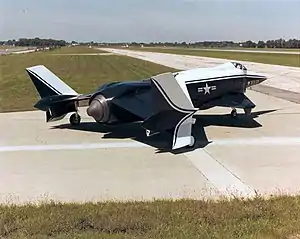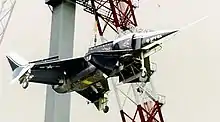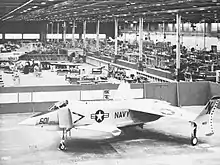Rockwell XFV-12
The Rockwell XFV-12 was a prototype supersonic United States Navy fighter which was built in 1977. The XFV-12 design attempted to combine the Mach 2 speed and AIM-7 Sparrow armament of the McDonnell Douglas F-4 Phantom II in a VTOL (vertical takeoff and landing) fighter for the small Sea Control Ship which was under study at the time. On paper, it looked superior to the subsonic Hawker Siddeley Harrier attack fighter. However, its inability to meet performance requirements terminated the program.
| XFV-12 | |
|---|---|
 | |
| XFV-12A on ramp at NAA in Columbus, Ohio | |
| Role | VTOL fighter |
| Manufacturer | Rockwell International |
| Status | Cancelled (1981) |
| Primary user | United States Navy |
| Number built | 1 |
Design and development


In 1972, the Navy issued a request for proposals for a next generation supersonic V/STOL fighter/attack aircraft. Rockwell's design with the XFV-12 won against Convair's proposal with the Convair Model 200.[1] The XFV-12A, despite its concept being considered risky compared to that of the Harrier, was selected for development.[2]
To reduce costs, the nose from a Douglas A-4 Skyhawk and intakes from the F-4 were used. Engine rig testing began in 1974.[3] Free-flight model tests conducted at the NASA Langley full-scale wind tunnel showed the projected thrust augmentation levels were highly optimistic, and that the aircraft would most likely be incapable of vertical flight on the thrust available, while the design remained suitable for conventional flight.[2]
The XFV-12 used a thrust augmented wing concept[3] in which exhaust would be directed through spaces in a wing opened up like venetian blinds to increase available lift, somewhat like Lockheed's unsuccessful XV-4 Hummingbird. Such arrangement restricted weapons carriage to under the narrow fuselage and two conformal missile mounts. Its canards were extremely large, with almost 50% of the area of the wings, making it effectively a tandem wing. The 30,000 lbf (130 kN)-class afterburning turbofan engine had enough thrust to lift the weight of the 20,000 lb (9,072 kg) aircraft. It was modified to further increase thrust for vertical lift. The rear engine exhaust was closed and the gases redirected through ducts to ejector nozzles in the wings and canards for vertical lift.
Operational history
Ground testing of the XFV-12A began in July 1977, and the aircraft was officially rolled out at the Rockwell International facility in Columbus, Ohio on 26 August.[2] Due to increasing costs, construction of the second prototype was abandoned.[2]
Tethered hover tests were conducted in 1978.[2] Over the course of six months, it was determined that the XFV-12A design suffered from major deficiencies with regard to vertical flight, especially a lack of sufficient vertical thrust.[2] Lab tests showed 55% thrust augmentation should be expected; however, differences in the scaled-up system dropped augmentation levels to 19% for the wing and a mere 6% in the canard.[2] While the augmenters did work as expected, the extensive ducting of the propulsion system degraded thrust, and in the end the power-to-weight ratio was such that the engine was capable of vertically lifting only 75% of the weight of the aircraft in which it was mounted.[2]
Following the tests, and with the program suffering from cost overruns, the Navy decided the XFV-12A was not worth further development, and cancelled the project in 1981.[2] Aviation Week would later publish an article with drawings of an even more ambitious proposal to fit a similar wing to the Lockheed C-130 Hercules, but the plan never made it off the drawing board.
Of the two prototypes built, only one was completed, while the second prototype was cancelled.[4]
The United States Marine Corps had adopted the British-designed Harrier, the only truly successful V/STOL design of the 1960s. Its replacement, the Lockheed Martin F-35 Lightning II, uses a shaft-driven fan and a swivelling rear nozzle to achieve vertical landing. It is designed for supersonic and vertical flight with performance just over Mach 1.5 with weapons and range comparable to the older F-4 and F-18.
Surviving aircraft
Following program cancellation, the aircraft was disassembled and the cockpit section of the fuselage was stored at NASA's Plum Brook Station in Sandusky, Ohio. As of May 2012, a group of high school students at the EHOVE Career Center, with guidance from NASA contractor personnel, were to restore the fuselage for use as a museum display.[5][6]
Specifications
Data from Jane's All the World's Aircraft 1979–80,[7] Jane's All the World's Aircraft 1980–81[8]
General characteristics
- Crew: 1
- Length: 43 ft 11 in (13.39 m)
- Wingspan: 28 ft 6.25 in (8.6932 m)
- Height: 10 ft 4 in (3.15 m)
- Wing area: 293 sq ft (27.2 m2)
- Empty weight: 13,800 lb (6,260 kg)
- Gross weight: 19,500 lb (8,845 kg)
- Max takeoff weight: 24,250 lb (11,000 kg)
- Fuel capacity: 2,763 l (730 US gal; 608 imp gal) in two fuselage bladder tanks and two integral wing tanks
- Powerplant: 1 × Pratt & Whitney F401-PW-400 afterburning turbofan engine, 30,000 lbf (130 kN) with afterburner
Performance
- Maximum speed: Mach 2.2-2.4
- Thrust/weight: 1.5 (conventional)
- Take-off run: 300 ft (91 m) at 24,250 lb (11,000 kg)
Armament
- Guns: 1 20 mm M61 Vulcan cannon, 639 rounds
- Missiles: 2 AIM-7 Sparrow (carried under fuselage) and 2 AIM-9L Sidewinder AAMs or 4 AIM-7s
See also
Aircraft of comparable role, configuration, and era
Related lists
References
- Notes
- Convair Advanced Desings II, Robert E Bradly, Special Press ISBN 978-0-8597917-0-0
- "GlobalSecurity.org". XFV-12. Retrieved 13 January 2007.
- "Historic Aircraft by Airborne Unlimited". Rockwell XFV-12. Retrieved 21 June 2010.
- Willis, 2006, p. 65
- "NASA Ask the Academy Young Professional Brief -- Maciej Zborowski". NASA. 28 October 2011. Archived from the original on 27 February 2013. Retrieved April 2013. Check date values in:
|access-date=(help) - Payerchin, Richard (28 May 2012). "NASA, EHOVE students team up to restore jet". The Morning Journal. Retrieved April 2013. Check date values in:
|access-date=(help) - Taylor, John W.R.; Munson, Kenneth, eds. (1979). Jane's All the World's Aircraft 1979–80 (69th ed.). London: Jane's Yearbooks. ISBN 978-0531039151.
- Taylor, John W.R., ed. (1980). Jane's All the World's Aircraft 1980–81 (71st ed.). London: Jane's Publishing Co. p. 430. ISBN 0-7106-0705-9.
- Bibliography
- Buttler, Tony. American Secret Projects, Fighters & Interceptors 1945-1978. Hinckley, UK: Midland Publishing. 2007. ISBN 1-85780-264-0.
- Winchester, Jim. X-Planes and Prototypes. Barnes and Noble Books.
- Willis, David (2006). "V for Variety, part one". Air Enthusiast. Key Publishing. July/August 2006 (124): 55–65. ISSN 0143-5450.
- "XFV-12A V/Stol in need of a lift". Flight International: 171. 20 January 1979.
External links
| Wikimedia Commons has media related to Rockwell XFV-12. |